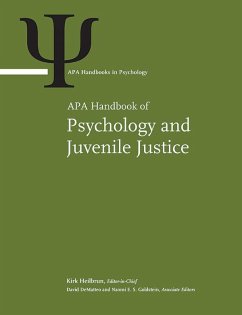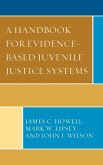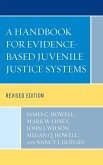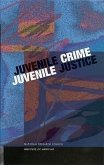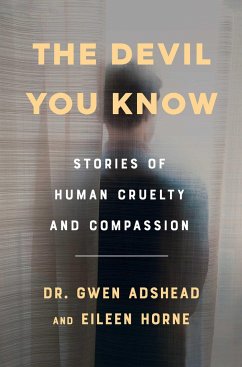Kirk Heilbrun
APA Handbook of Psychology and Juvenile Justice
Herausgeber: Heilbrun, Kirk; Goldstein, Naomi E S; Dematteo, David
Kirk Heilbrun
APA Handbook of Psychology and Juvenile Justice
Herausgeber: Heilbrun, Kirk; Goldstein, Naomi E S; Dematteo, David
- Gebundenes Buch
- Merkliste
- Auf die Merkliste
- Bewerten Bewerten
- Teilen
- Produkt teilen
- Produkterinnerung
- Produkterinnerung
The APA Handbook of Psychology and Juvenile Justice consolidates and advances knowledge about the legal, scientific, and applied foundations of the juvenile justice system. In addition to an overview of the area, it contains chapters in the following sections: * Relevant Law (focusing on important legislation and on U.S. Supreme Court decisions from Kent and Gault to Eddings, Roper, Graham, and Miller-Jackson, and on the relevant legal theory of preventive justice for adolescents) * Human Development (describing research on adolescent development and brain development as they apply to…mehr
Andere Kunden interessierten sich auch für
![Handbook for Evidence-Based Juvenile Justice Systems Handbook for Evidence-Based Juvenile Justice Systems]() James C HowellHandbook for Evidence-Based Juvenile Justice Systems113,99 €
James C HowellHandbook for Evidence-Based Juvenile Justice Systems113,99 €![Handbook for Evidence-Based Juvenile Justice Systems Handbook for Evidence-Based Juvenile Justice Systems]() James C HowellHandbook for Evidence-Based Juvenile Justice Systems104,99 €
James C HowellHandbook for Evidence-Based Juvenile Justice Systems104,99 €![Women Street Hustlers Women Street Hustlers]() Barbara A RockellWomen Street Hustlers20,99 €
Barbara A RockellWomen Street Hustlers20,99 €![Juvenile Crime, Juvenile Justice Juvenile Crime, Juvenile Justice]() Institute Of MedicineJuvenile Crime, Juvenile Justice47,99 €
Institute Of MedicineJuvenile Crime, Juvenile Justice47,99 €![A New Juvenile Justice System A New Juvenile Justice System]() Nancy E. DowdA New Juvenile Justice System77,99 €
Nancy E. DowdA New Juvenile Justice System77,99 €![The Devil You Know The Devil You Know]() Gwen AdsheadThe Devil You Know21,99 €
Gwen AdsheadThe Devil You Know21,99 €![Race and Ethnicity in the Juvenile and Criminal Justice Systems Race and Ethnicity in the Juvenile and Criminal Justice Systems]() Race and Ethnicity in the Juvenile and Criminal Justice Systems177,99 €
Race and Ethnicity in the Juvenile and Criminal Justice Systems177,99 €-
-
-
The APA Handbook of Psychology and Juvenile Justice consolidates and advances knowledge about the legal, scientific, and applied foundations of the juvenile justice system. In addition to an overview of the area, it contains chapters in the following sections: * Relevant Law (focusing on important legislation and on U.S. Supreme Court decisions from Kent and Gault to Eddings, Roper, Graham, and Miller-Jackson, and on the relevant legal theory of preventive justice for adolescents) * Human Development (describing research on adolescent development and brain development as they apply to behavior in the juvenile justice context) * Patterns of Offending (including evidence about offending in juveniles and the persistence vs. desistance into adulthood) * Risk Factors for Offending (evidence about risk factors for juvenile offending including Risk-Need-Responsivity theory, juvenile psychopathy, substance abuse, gangs, and trauma/adverse experience, as well as threat assessment and bullying prevention in schools) * Forensic Assessment (assessing risk, needs/amenability, and sophistication-maturity as part of legal decisions on commitment, transfer, and reverse transfer, as well as legal decisions on Miranda waiver capacity and competence to stand trial) * Interventions (evidence on risk-reducing interventions, both in the community and in residential placement, including for specialized offending of sexual offenders) * Training and Ethics (including the updated MacArthur curriculum on adolescents in the juvenile justice system and an analysis of the ethical issues particular to juvenile justice)
Produktdetails
- Produktdetails
- Verlag: American Psychological Association (APA)
- Seitenzahl: 735
- Erscheinungstermin: 17. August 2015
- Englisch
- Abmessung: 287mm x 221mm x 43mm
- Gewicht: 1905g
- ISBN-13: 9781433819674
- ISBN-10: 1433819678
- Artikelnr.: 42858763
- Herstellerkennzeichnung
- Libri GmbH
- Europaallee 1
- 36244 Bad Hersfeld
- gpsr@libri.de
- Verlag: American Psychological Association (APA)
- Seitenzahl: 735
- Erscheinungstermin: 17. August 2015
- Englisch
- Abmessung: 287mm x 221mm x 43mm
- Gewicht: 1905g
- ISBN-13: 9781433819674
- ISBN-10: 1433819678
- Artikelnr.: 42858763
- Herstellerkennzeichnung
- Libri GmbH
- Europaallee 1
- 36244 Bad Hersfeld
- gpsr@libri.de
Kirk Heilbrun, PhD, is a professor and interim head of the department of psychology at Drexel University, and codirector of the Pennsylvania Mental Health and Justice Center of Excellence. He received his doctorate in clinical psychology in 98 from the University of Texas at Austin and completed postdoctoral fellowship training from 98 to 982 in psychology and criminal justice at Florida State University. His current research focuses on juvenile and adult offenders, legal decision-making, forensic evaluation associated with such decision-making, and diversion. Dr. Heilbrun is the author of numerous articles on forensic assessment, violence risk assessment and risk communication, and the treatment of offenders with mental disorders, and he has published books (Principles of Forensic Mental Health Assessment, 2 Forensic Mental Health Assessment: A Casebook, with Geoffrey R. Marczyk and David DeMatteo, 2 2 Forensic Mental Health Assessment: A Casebook, Second Edition, with David DeMatteo, Stephanie Brooks Holliday, and Casey LaDuke, 2 4 Juvenile Delinquency: Prevention, Assessment, and Intervention, with Naomi E. Sevin Goldstein and Richard E. Redding, 2 5 Wrightsman's Psychology and the Legal System, Sixth Edition, with Edie Greene, William H. Fortune, and Michael T. Nietzel, 2 Wrightsman's Psychology and the Legal System, Seventh Edition, with Edie Greene, 2 Wrightsman's Psychology and the Legal System, Eighth Edition, with Edie Greene, 2 3 Foundations of Forensic Mental Health Assessment, with Thomas Grisso and Alan Goldstein, 2 9 Evaluating the Risk of Violence in Adults, 2 9 and The Sequential Intercept Model and Criminal Justice: Promoting Community Alternatives for Individuals With Severe Mental Illness , with Patricia A. Griffin, Edward P. Mulvey, David DeMatteo, and Carol A. Schubert, 2 5). His practice interests also center on forensic assessment, and he directs a clinic in this area in the department of psychology at Drexel University. He is board certified in clinical psychology and in forensic psychology (American Board of Professional Psychology) and has previously served as president of both APA Division 4 (American Psychology-Law Society), and the American Board of Forensic Psychology. Dr. Heilbrun received the 2 4 Distinguished Contributions to Forensic Psychology Award and the 2 8 Beth Clark Distinguished Service Contribution Award from the American Academy of Forensic Psychology.
Editorial Board
About the Editor-in-Chief
Contributors
Series Preface
Introduction
I. Overview
1. Psychology and Juvenile Justice: Human Development, Law, Science, and
Practice
Kirk Heilbrun, David DeMatteo, Naomi E. S. Goldstein, Benjamin
Locklair, Megan Murphy, and Christy Giallella
II. Law
1. Children in the Justice System: The Legal Framework
Marsha Levick and Jessica Feierman
2. Preventive Justice for Adolescents
Christopher Slobogin
III. Human Development
1. Human Development and Juvenile Justice
Elizabeth P. Shulman and Laurence Steinberg
2. Adolescent Brain Development: Implications to the Juvenile Criminal
Justice System
Beatriz Luna and Catherine Wright
3. Adolescent Development, Mental Disorder, and Decision-Making in
Delinquent Youths
Alison G. Nagel, Lucy A. Guarnera, and N. Dickon Reppucci
IV. Patterns of Offending
1. Serious Questions About Serious Juvenile Offenders: Patterns of
Offending and Offenses
Jennifer L. Woolard and Erika Fountain
2. Desistance and Life-Course Persistence: Findings From Longitudinal
Studies Using Group-Based Trajectory Modeling of Antisocial Behavior
Michael A. Russell and Candice L. Odgers
V. Risk Factors for Offending
1. Risk, Need, and Responsivity in Juveniles
Robert D. Hoge
2. Juvenile Psychopathy: Appropriate and Inappropriate Uses in Legal
Proceedings
Gina M. Vincent, Eva R. Kimonis, and Alisa Clark
3. School-Based Risk Factors, Bullying, and Threat Assessment
Dewey Cornell and Anna Heilbrun
4. Disrupting the School-to-Prison Pipeline: Strategies to Reduce the
Risk of School-Based Zero Tolerance Policies Resulting in Juvenile
Justice Involvement
Brian P. Daly, Aimee K. Hildenbrand, Emily Haney-Caron, Naomi E. S.
Goldstein, Meghann Galloway, and David DeMatteo
5. Substance Use and Substance Use Disorders as Risk Factors for
Juvenile Offending
Laurie Chassin, Andre D. Mansion, Brandon Nichter, and Danielle
Pandika
6. Gangs
Wesley G. Jennings and Jennifer M. Reingle Gonzalez
7. Trauma, Adverse Experience, and Offending
Amanda D. Zelechoski
VI. Forensic Assessment
1. Forensic Assessment of Juveniles
Kirk Heilbrun and Benjamin Locklair
2. Risk Assessment With Juveniles
David DeMatteo, Melinda Wolbransky, and Casey LaDuke
3. Distinguishing and Assessing Treatment Needs and Amenability to
Rehabilitation
Robert T. Kinscherff
4. Developmental Maturity and Sophistication amp ndash Maturity:
Learning More About Its Purpose and Assessment
Randall T. Salekin, Emily A. M. MacDougall, and Natalie A. Harrison
5. Forensic Uses of Clinical Assessment Instruments
Robert P. Archer and Linda J. Baum
6. Transfer and Commitment of Youth in the United States: Law, Policy,
and Forensic Practice
Kimberly Larson and Thomas Grisso
7. Evaluation of Miranda Waiver Capacity
Naomi E. S. Goldstein, Sharon Messenheimer Kelley, Lindsey Peterson,
Leah Brogan, Heather Zelle, and Christina Riggs Romaine
8. Evaluation and Restoration of Competency to Stand Trial
Janet I. Warren, Shelly L. Jackson, and Jessica Jones Coburn
VII. Interventions and Costs
1. Risk Reduction Interventions for Adolescent Offenders
Jodi L. Viljoen, Etta Brodersen, Catherine Shaffer, and Robert J.
McMahon
2. Trauma-Informed Juvenile Justice Systems and Approaches
Jessica Feierman and Julian D. Ford
3. Community-Based Interventions for Juvenile Offenders
Scott W. Henggeler
4. Intervening in the Community to Treat Trauma in Young Men of Color
John Rich, Erica J. Harris, Sandra L. Bloom, Linda Rich, and Theodore
Corbin
5. Residential Interventions With Justice-Involved Youth
Keith R. Cruise, Samantha L. Morin, and Katelyn Affleck
6. Sexual Offending: Assessment and Intervention
Robert A. Prentky, Sue Righthand, and Raina Lamade
VIII. Training and Ethics
1. Training Mental Health and Juvenile Justice Professionals in Juvenile
Screening, Assessment, and Evaluation
Lourdes M. Rosado and Mary Ann Scali
2. Ethical Issues in Psychology and Juvenile Justice
Gerald P. Koocher and Robert T. Kinscherff
Index
About the Editor-in-Chief
Contributors
Series Preface
Introduction
I. Overview
1. Psychology and Juvenile Justice: Human Development, Law, Science, and
Practice
Kirk Heilbrun, David DeMatteo, Naomi E. S. Goldstein, Benjamin
Locklair, Megan Murphy, and Christy Giallella
II. Law
1. Children in the Justice System: The Legal Framework
Marsha Levick and Jessica Feierman
2. Preventive Justice for Adolescents
Christopher Slobogin
III. Human Development
1. Human Development and Juvenile Justice
Elizabeth P. Shulman and Laurence Steinberg
2. Adolescent Brain Development: Implications to the Juvenile Criminal
Justice System
Beatriz Luna and Catherine Wright
3. Adolescent Development, Mental Disorder, and Decision-Making in
Delinquent Youths
Alison G. Nagel, Lucy A. Guarnera, and N. Dickon Reppucci
IV. Patterns of Offending
1. Serious Questions About Serious Juvenile Offenders: Patterns of
Offending and Offenses
Jennifer L. Woolard and Erika Fountain
2. Desistance and Life-Course Persistence: Findings From Longitudinal
Studies Using Group-Based Trajectory Modeling of Antisocial Behavior
Michael A. Russell and Candice L. Odgers
V. Risk Factors for Offending
1. Risk, Need, and Responsivity in Juveniles
Robert D. Hoge
2. Juvenile Psychopathy: Appropriate and Inappropriate Uses in Legal
Proceedings
Gina M. Vincent, Eva R. Kimonis, and Alisa Clark
3. School-Based Risk Factors, Bullying, and Threat Assessment
Dewey Cornell and Anna Heilbrun
4. Disrupting the School-to-Prison Pipeline: Strategies to Reduce the
Risk of School-Based Zero Tolerance Policies Resulting in Juvenile
Justice Involvement
Brian P. Daly, Aimee K. Hildenbrand, Emily Haney-Caron, Naomi E. S.
Goldstein, Meghann Galloway, and David DeMatteo
5. Substance Use and Substance Use Disorders as Risk Factors for
Juvenile Offending
Laurie Chassin, Andre D. Mansion, Brandon Nichter, and Danielle
Pandika
6. Gangs
Wesley G. Jennings and Jennifer M. Reingle Gonzalez
7. Trauma, Adverse Experience, and Offending
Amanda D. Zelechoski
VI. Forensic Assessment
1. Forensic Assessment of Juveniles
Kirk Heilbrun and Benjamin Locklair
2. Risk Assessment With Juveniles
David DeMatteo, Melinda Wolbransky, and Casey LaDuke
3. Distinguishing and Assessing Treatment Needs and Amenability to
Rehabilitation
Robert T. Kinscherff
4. Developmental Maturity and Sophistication amp ndash Maturity:
Learning More About Its Purpose and Assessment
Randall T. Salekin, Emily A. M. MacDougall, and Natalie A. Harrison
5. Forensic Uses of Clinical Assessment Instruments
Robert P. Archer and Linda J. Baum
6. Transfer and Commitment of Youth in the United States: Law, Policy,
and Forensic Practice
Kimberly Larson and Thomas Grisso
7. Evaluation of Miranda Waiver Capacity
Naomi E. S. Goldstein, Sharon Messenheimer Kelley, Lindsey Peterson,
Leah Brogan, Heather Zelle, and Christina Riggs Romaine
8. Evaluation and Restoration of Competency to Stand Trial
Janet I. Warren, Shelly L. Jackson, and Jessica Jones Coburn
VII. Interventions and Costs
1. Risk Reduction Interventions for Adolescent Offenders
Jodi L. Viljoen, Etta Brodersen, Catherine Shaffer, and Robert J.
McMahon
2. Trauma-Informed Juvenile Justice Systems and Approaches
Jessica Feierman and Julian D. Ford
3. Community-Based Interventions for Juvenile Offenders
Scott W. Henggeler
4. Intervening in the Community to Treat Trauma in Young Men of Color
John Rich, Erica J. Harris, Sandra L. Bloom, Linda Rich, and Theodore
Corbin
5. Residential Interventions With Justice-Involved Youth
Keith R. Cruise, Samantha L. Morin, and Katelyn Affleck
6. Sexual Offending: Assessment and Intervention
Robert A. Prentky, Sue Righthand, and Raina Lamade
VIII. Training and Ethics
1. Training Mental Health and Juvenile Justice Professionals in Juvenile
Screening, Assessment, and Evaluation
Lourdes M. Rosado and Mary Ann Scali
2. Ethical Issues in Psychology and Juvenile Justice
Gerald P. Koocher and Robert T. Kinscherff
Index
Editorial Board
About the Editor-in-Chief
Contributors
Series Preface
Introduction
I. Overview
1. Psychology and Juvenile Justice: Human Development, Law, Science, and
Practice
Kirk Heilbrun, David DeMatteo, Naomi E. S. Goldstein, Benjamin
Locklair, Megan Murphy, and Christy Giallella
II. Law
1. Children in the Justice System: The Legal Framework
Marsha Levick and Jessica Feierman
2. Preventive Justice for Adolescents
Christopher Slobogin
III. Human Development
1. Human Development and Juvenile Justice
Elizabeth P. Shulman and Laurence Steinberg
2. Adolescent Brain Development: Implications to the Juvenile Criminal
Justice System
Beatriz Luna and Catherine Wright
3. Adolescent Development, Mental Disorder, and Decision-Making in
Delinquent Youths
Alison G. Nagel, Lucy A. Guarnera, and N. Dickon Reppucci
IV. Patterns of Offending
1. Serious Questions About Serious Juvenile Offenders: Patterns of
Offending and Offenses
Jennifer L. Woolard and Erika Fountain
2. Desistance and Life-Course Persistence: Findings From Longitudinal
Studies Using Group-Based Trajectory Modeling of Antisocial Behavior
Michael A. Russell and Candice L. Odgers
V. Risk Factors for Offending
1. Risk, Need, and Responsivity in Juveniles
Robert D. Hoge
2. Juvenile Psychopathy: Appropriate and Inappropriate Uses in Legal
Proceedings
Gina M. Vincent, Eva R. Kimonis, and Alisa Clark
3. School-Based Risk Factors, Bullying, and Threat Assessment
Dewey Cornell and Anna Heilbrun
4. Disrupting the School-to-Prison Pipeline: Strategies to Reduce the
Risk of School-Based Zero Tolerance Policies Resulting in Juvenile
Justice Involvement
Brian P. Daly, Aimee K. Hildenbrand, Emily Haney-Caron, Naomi E. S.
Goldstein, Meghann Galloway, and David DeMatteo
5. Substance Use and Substance Use Disorders as Risk Factors for
Juvenile Offending
Laurie Chassin, Andre D. Mansion, Brandon Nichter, and Danielle
Pandika
6. Gangs
Wesley G. Jennings and Jennifer M. Reingle Gonzalez
7. Trauma, Adverse Experience, and Offending
Amanda D. Zelechoski
VI. Forensic Assessment
1. Forensic Assessment of Juveniles
Kirk Heilbrun and Benjamin Locklair
2. Risk Assessment With Juveniles
David DeMatteo, Melinda Wolbransky, and Casey LaDuke
3. Distinguishing and Assessing Treatment Needs and Amenability to
Rehabilitation
Robert T. Kinscherff
4. Developmental Maturity and Sophistication amp ndash Maturity:
Learning More About Its Purpose and Assessment
Randall T. Salekin, Emily A. M. MacDougall, and Natalie A. Harrison
5. Forensic Uses of Clinical Assessment Instruments
Robert P. Archer and Linda J. Baum
6. Transfer and Commitment of Youth in the United States: Law, Policy,
and Forensic Practice
Kimberly Larson and Thomas Grisso
7. Evaluation of Miranda Waiver Capacity
Naomi E. S. Goldstein, Sharon Messenheimer Kelley, Lindsey Peterson,
Leah Brogan, Heather Zelle, and Christina Riggs Romaine
8. Evaluation and Restoration of Competency to Stand Trial
Janet I. Warren, Shelly L. Jackson, and Jessica Jones Coburn
VII. Interventions and Costs
1. Risk Reduction Interventions for Adolescent Offenders
Jodi L. Viljoen, Etta Brodersen, Catherine Shaffer, and Robert J.
McMahon
2. Trauma-Informed Juvenile Justice Systems and Approaches
Jessica Feierman and Julian D. Ford
3. Community-Based Interventions for Juvenile Offenders
Scott W. Henggeler
4. Intervening in the Community to Treat Trauma in Young Men of Color
John Rich, Erica J. Harris, Sandra L. Bloom, Linda Rich, and Theodore
Corbin
5. Residential Interventions With Justice-Involved Youth
Keith R. Cruise, Samantha L. Morin, and Katelyn Affleck
6. Sexual Offending: Assessment and Intervention
Robert A. Prentky, Sue Righthand, and Raina Lamade
VIII. Training and Ethics
1. Training Mental Health and Juvenile Justice Professionals in Juvenile
Screening, Assessment, and Evaluation
Lourdes M. Rosado and Mary Ann Scali
2. Ethical Issues in Psychology and Juvenile Justice
Gerald P. Koocher and Robert T. Kinscherff
Index
About the Editor-in-Chief
Contributors
Series Preface
Introduction
I. Overview
1. Psychology and Juvenile Justice: Human Development, Law, Science, and
Practice
Kirk Heilbrun, David DeMatteo, Naomi E. S. Goldstein, Benjamin
Locklair, Megan Murphy, and Christy Giallella
II. Law
1. Children in the Justice System: The Legal Framework
Marsha Levick and Jessica Feierman
2. Preventive Justice for Adolescents
Christopher Slobogin
III. Human Development
1. Human Development and Juvenile Justice
Elizabeth P. Shulman and Laurence Steinberg
2. Adolescent Brain Development: Implications to the Juvenile Criminal
Justice System
Beatriz Luna and Catherine Wright
3. Adolescent Development, Mental Disorder, and Decision-Making in
Delinquent Youths
Alison G. Nagel, Lucy A. Guarnera, and N. Dickon Reppucci
IV. Patterns of Offending
1. Serious Questions About Serious Juvenile Offenders: Patterns of
Offending and Offenses
Jennifer L. Woolard and Erika Fountain
2. Desistance and Life-Course Persistence: Findings From Longitudinal
Studies Using Group-Based Trajectory Modeling of Antisocial Behavior
Michael A. Russell and Candice L. Odgers
V. Risk Factors for Offending
1. Risk, Need, and Responsivity in Juveniles
Robert D. Hoge
2. Juvenile Psychopathy: Appropriate and Inappropriate Uses in Legal
Proceedings
Gina M. Vincent, Eva R. Kimonis, and Alisa Clark
3. School-Based Risk Factors, Bullying, and Threat Assessment
Dewey Cornell and Anna Heilbrun
4. Disrupting the School-to-Prison Pipeline: Strategies to Reduce the
Risk of School-Based Zero Tolerance Policies Resulting in Juvenile
Justice Involvement
Brian P. Daly, Aimee K. Hildenbrand, Emily Haney-Caron, Naomi E. S.
Goldstein, Meghann Galloway, and David DeMatteo
5. Substance Use and Substance Use Disorders as Risk Factors for
Juvenile Offending
Laurie Chassin, Andre D. Mansion, Brandon Nichter, and Danielle
Pandika
6. Gangs
Wesley G. Jennings and Jennifer M. Reingle Gonzalez
7. Trauma, Adverse Experience, and Offending
Amanda D. Zelechoski
VI. Forensic Assessment
1. Forensic Assessment of Juveniles
Kirk Heilbrun and Benjamin Locklair
2. Risk Assessment With Juveniles
David DeMatteo, Melinda Wolbransky, and Casey LaDuke
3. Distinguishing and Assessing Treatment Needs and Amenability to
Rehabilitation
Robert T. Kinscherff
4. Developmental Maturity and Sophistication amp ndash Maturity:
Learning More About Its Purpose and Assessment
Randall T. Salekin, Emily A. M. MacDougall, and Natalie A. Harrison
5. Forensic Uses of Clinical Assessment Instruments
Robert P. Archer and Linda J. Baum
6. Transfer and Commitment of Youth in the United States: Law, Policy,
and Forensic Practice
Kimberly Larson and Thomas Grisso
7. Evaluation of Miranda Waiver Capacity
Naomi E. S. Goldstein, Sharon Messenheimer Kelley, Lindsey Peterson,
Leah Brogan, Heather Zelle, and Christina Riggs Romaine
8. Evaluation and Restoration of Competency to Stand Trial
Janet I. Warren, Shelly L. Jackson, and Jessica Jones Coburn
VII. Interventions and Costs
1. Risk Reduction Interventions for Adolescent Offenders
Jodi L. Viljoen, Etta Brodersen, Catherine Shaffer, and Robert J.
McMahon
2. Trauma-Informed Juvenile Justice Systems and Approaches
Jessica Feierman and Julian D. Ford
3. Community-Based Interventions for Juvenile Offenders
Scott W. Henggeler
4. Intervening in the Community to Treat Trauma in Young Men of Color
John Rich, Erica J. Harris, Sandra L. Bloom, Linda Rich, and Theodore
Corbin
5. Residential Interventions With Justice-Involved Youth
Keith R. Cruise, Samantha L. Morin, and Katelyn Affleck
6. Sexual Offending: Assessment and Intervention
Robert A. Prentky, Sue Righthand, and Raina Lamade
VIII. Training and Ethics
1. Training Mental Health and Juvenile Justice Professionals in Juvenile
Screening, Assessment, and Evaluation
Lourdes M. Rosado and Mary Ann Scali
2. Ethical Issues in Psychology and Juvenile Justice
Gerald P. Koocher and Robert T. Kinscherff
Index

